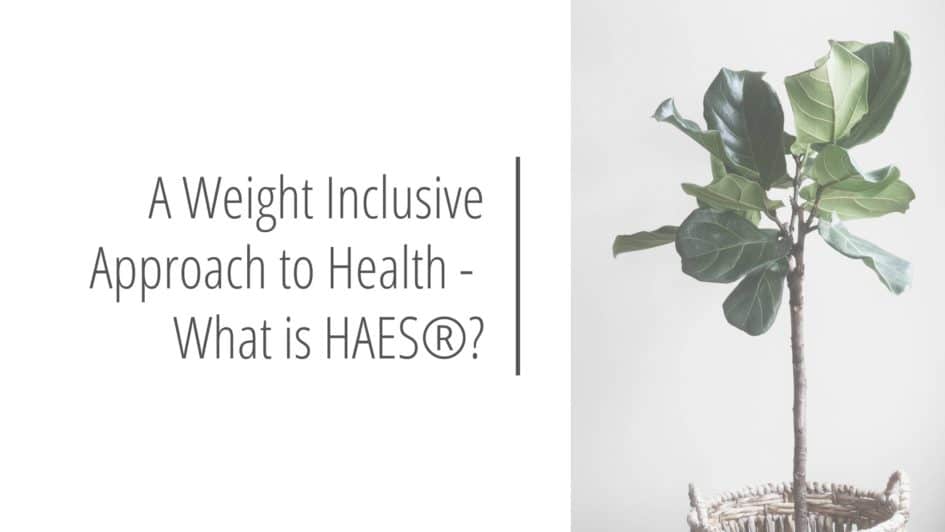Table of Contents
What is a Weight Inclusive Approach?
A weight-inclusive approach involves meeting people where they’re at on their health journey, regardless of weight. Within this approach, one does not assume the health status of another based on weight or BMI. This acknowledges that health is a complex combination of factors, not simply a number on the scale.
Additionally, health goals do not revolve around intentionally changing the weight of an individual. Instead, goals involve developing healthful habits that will positively impact overall health, both physical and mental.
Weight inclusive care aims to eliminate weight stigma and provide individuals of all body sizes access to proper health care. It aims to break down barriers and create equity in the health care system.
The Origins of HAES
Please note that his blog post is meant to serve only as a general overview of Health at Every Size (HAES). HAES is a complex weight inclusive approach and movement that cannot be completely explained or understood through a single article.
The Health at Every Size approach was brought about when the Association for Size Diversity and Health (ASDAH) was first created in 2013.
HAES was formed from discussions that occurred among health care workers, consumers, and activists. These individuals all reject the use of weight, size, or BMI as indicators for health. They also reject the myth that weight is a person’s choice.
The ASDAH supports a holistic definition of health that is not characterized by the presence or absence of illness, limitations, or disease. Instead, an individual’s health falls upon a continuum that varies with time and circumstance.
The ASDAH believes that a person’s health should not determine the value or be used to judge an individual.
The Overall Focus of HAES
- Size acceptance/diversity
- Weight inclusive approach
- Intuitive approaches to eating
- Pursuing both individualized and enjoyable physical activity
- Safe and affordable health care that is free of judgment
- Recognizing that health is a multi-faceted concept.
From these ideas and beliefs, the HAES principles were developed and re-developed over the past years (1).
Health at Every Size Principles
1. Weight Inclusivity
This involves accepting and respecting the diversity of bodies when it comes to shapes and sizes. This also means rejecting the idealization of specific body weights.
2. Health Enhancement:
This principle involves supporting health policies that focus on improving and equalizing access to helpful information and services. Not only this but supporting policies that focus on personal practices that improve overall wellness. This includes attention to a person’s physical, economic, social, spiritual, emotional, and other related needs.
3. Respectful Care
Individuals of all sizes deserve safe and equitable access to health care services.
This is where it can get hard for people. We have to acknowledge our biases, which is difficult for many people because biases can be ingrained or unidentified. However, in order to advocate for HAES, we have to put an end to any biases revolving around health.
Additionally, we must be able to provide information and services without bias to people of varying socioeconomic status, race, gender, age, and more. In other words, if you can’t leave your personal biases at the door, then HAES might not be the right approach for you.
4. Eating for Well-being
This involves promoting flexible eating patterns that are based on hunger, satiety, individual nutrition needs, and personal satisfaction. There is no place for a restrictive eating plan focused on weight loss.
This is a great area to combine HAES and Intuitive Eating.
5. Life-Enhancing Movement
This focuses on encouraging individualized, enjoyable exercise. Physical activity does not look the same for everyone. In other words, people vary in size, abilities, as well as interests and their physical activity performed should take these aspects into consideration.
Join me on Instagram every Monday for Movement Mondays, where I encourage you to practice joyful movement each week!
Research Studies about Using a Weight Inclusive Approach
Initially, when I first heard about HAES, I was overwhelmed. Overwhelmed with excitement, curiosity, and desire to learn more! If you’re like me and want to learn a little more about HAES… keep reading. Feel free to link to the article itself to read an in-depth explanation.
Research Example 1
This research study involved 326 “weight-preoccupied” adult women pursuing health through weight loss at a local health services center.
The purpose of this study was to determine the outcomes of the Health at Every Size (HAES) intervention in a real-world setting.
Using the HAES intervention, the participants were educated on the biological, psychological, and sociocultural aspects of body weight. Additionally, info was obtained regarding participants’ eating behaviors, psychological stress, and BMI.
After the HAES intervention was successfully completed, the results demonstrated improvement in eating-, weight-, and psychological-related variables when it comes to short and long term struggles with weight and body image. The results also demonstrated that using the principles of HAES can lead to improvements in overall health without accompanying weight loss (2).
Research Example 2
This 7-month prospective, randomized control trial (RCT) involved 58 participants. The intervention group (n=39) participated in an intensified HAES intervention. On the other hand, the control group (n=19) participated in a traditional HAES intervention.
The intervention group showed significant decreases in poor body image perception and significant increases in facts such as “attractiveness.” Additionally, this group showed a significant increase in the consumption of fruits and vegetables (3).
Research Example 3
This research study consisted of 11 weekly 2-hour psychotherapy group sessions. The group sessions were structured as a closed group with a single facilitator.
The goal of this study was to examine the effect of combining HAES and ACT (Acceptance and Commitment Therapy) interventions on depressed, obese women.
All sessions included behavioral homework assignments, 30-60 minutes review of previous homework, 5-10 minutes, and 50-85 minutes of new material. In addition, the participants were encouraged to offer one another support outside of the group.
The results showed an improvement in self-acceptance, reduction in guilt when eating, acceptance of body weight as is, acceptance of the non-diet approach, an increase in self-esteem, and more (4).
Research Example 4
This article reviews various published research regarding obesity, HAES, and public health policy.
The article examined how weight loss as a solution to the “obesity epidemic” is not an effective approach to take. This is leading to a new idea revolving around a non-diet, weight inclusive approach to health.
In conclusion, this article discovered that the most effective method of addressing chronic disease is to focus on health rather than an individual’s weight. Additionally, it found that abandoning traditional weight loss methods and focusing on the HAES method can increase an individual’s overall physical and mental health (5).
Quick Summary
Health at Every Size (HAES) is a weight inclusive approach to health. This means HAES acknowledges that health is a complex subject that involves more than a number on a scale. HAES believes in respectful care and proper health care access for individuals of all body sizes. HAES is an evidence-based framework that aims to eliminate weight stigma and discrimination.
The 5 HAES Principles:
- Weight Inclusivity
- Health Enhancement
- Respectful Care
- Eating for Well-Being
- Life Enhancing Movement
Interested in diving deeper into Health at Every Size? Check out the HAES category on my website.
Want to spread awareness of weight inclusive approaches like HAES, check out my anti-diet themed shop for fun HAES-themed items!
Thanks for reading!
Rachel Beiler, MHS, RD, LDN


8 Pingbacks